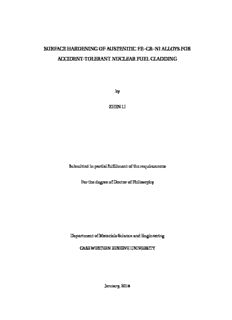
surface hardening of austenitic fe–cr–ni alloys for accident-tolerant nuclear fuel cladding PDF
Preview surface hardening of austenitic fe–cr–ni alloys for accident-tolerant nuclear fuel cladding
SURFACEHARDENINGOFAUSTENITICFE–CR–NIALLOYSFOR ACCIDENT-TOLERANTNUCLEARFUELCLADDING by ZHENLI Submittedinpartialfulfillmentoftherequirements ForthedegreeofDoctorofPhilosophy DepartmentofMaterialsScienceandEngineering CASEWESTERNRESERVEUNIVERSITY January,2018 SurfaceHardeningofAusteniticFe–Cr–NiAlloysForAccident-Tolerant NuclearFuelCladding CaseWesternReserveUniversity CaseSchoolofGraduateStudies Weherebyapprovethethesis1of ZHENLI forthedegreeof DoctorofPhilosophy Dr.FrankErnst 04/26/2017 CommitteeChair,Adviser Date DepartmentofMaterialsScienceandEngineering,CWRU Dr.ArthurHeuer 04/26/2017 CommitteeMember Date DepartmentofMaterialsScienceandEngineering,CWRU Dr.JohnLewandowski 04/26/2017 CommitteeMember Date DepartmentofMaterialsScienceandEngineering,CWRU Dr.SunnivaCollins 04/26/2017 CommitteeMember Date DepartmentofMechanicalandAerospaceEngineering,CWRU Dr.ScottLillard 04/26/2017 CommitteeMember Date DepartmentofChemicalandBiomolecularEngineering,TheUniversityofAkron 1Wecertifythatwrittenapprovalhasbeenobtainedforanyproprietarymaterialcontainedtherein. DedicatedtomywifeXunZhan,mydaughtersMacieLi,JoannaLi,my parentsLimingLi,YingnanFanandparentsinlawZhijunZhan,Liping Gaowithlove Table of Contents ListofTables vi ListofFigures vii Acknowledgements xv Acknowledgements xv Abstract xvi Abstract xvi Chapter1. Introduction 1 Motivation 1 MaterialsCandidate 2 ColossalSuper-saturationEngineering 8 Approach 15 Chapter2. Experimental 19 AAA(aqueousacidactivation) 20 GasPhaseProcessing 21 Characterization of CSS (colossal super-saturation)-Engineered Near-surface Region 25 PropertiesofCSS-engineeredNear-surfaceDiffusionZone 27 OxidizedandIrradiatedLTC/LTNCNear-surfaceRegionCharacterization 31 Chapter3. Results 33 LTC/LTNCNear-surfaceRegionCharacterization 33 iv PropertiesofLTC(low-temperaturecarburization)andLTNC(low-temperature nitro-carburization)Layers 53 Chapter4. Discussion 86 PossibleMechanismsofPassivationbyEthanol 86 CSS-engineeringofAISI-316L,AL-6XNandIN-718 89 OxidationTests 104 SCC(stresscorrosioncracking) 110 IrradiationTest 115 Chapter5. Conclusions 117 Chapter6. Futurework 120 AppendixA. AqueousAcidActivation 122 AppendixB. LongtermannealingofcarburizedAISI-316L 126 AppendixC. LTC(low-temperaturecarburization)ofnanostructuredAISI-316L 129 Appendix. CompleteReferences 132 v List of Tables 1.1 Mainchemicalcompositions(>1.0at%)ofAISI-316LSS,AL-6XN,and IN-718. Theunitofatomicconcentrationisat.%. 16 2.1 AISI-316LsamplespreparationparametersbeforeXPS. 21 2.2 ShapesanddimensionsofAISI-316L,AL-6XN,andIN-718samples. 22 2.3 Gasflowratesduringactivationandcarburizationprocess. 24 2.4 Gasflowratesduringnitro-carburizationofIN-718. 25 2.5 PostCSS-engineeringheatexposure 30 B.1 Carbonprofileintegrationratiobetweenas-carburized,air-annealed andvacuum-annealedAISI-316Lspecimens. 127 vi List of Figures 1.1 Optical micrographs of cross sections of Zircaloy-2 and AISI-317L after 28.8ks exposure to 1MPa steam at 1070K, 1270K, 1470K, respectively. (a)-(c)Zircaloy-2. (d)-(f)AISI-317L. 3 1.2 (a)Vickershardness(triangles)andcarbonconcentration(circles) depthprofiles. (b)Residualstressprofileofcarburized316Lstainless steel. 5 1.3 Potentiodynamicpolarizationcurvesofcarburizedandas-received AISI-316L, recorded in sea-water-like electrolyte (0.6M NaCl solution). 6 1.4 TTTdiagramsofanAISI-316austeniticSSwithtwodifferentatom fractionsX ofcarbon. 7 C 1.5 (a)J4915furnace. (b)MainchamberofJ4915furnace. 10 1.6 GasphaseLTCorLTNCprocess. 11 1.7 Metallographicimageofgasphase(C H )LTCofelectro-polished 2 2 AISI-316L. 12 1.8 Schematicstructureofaplasmaunit. 13 1.9 Schematicprocessofampoulemethodfornitro-carburization. 14 2.1 LTC(low-temperaturecarburization)recipesofAISI-316L,AL-6XN, andIN-718. 23 2.2 Typical nano-indentation setting for hardness depth profile of CSS-engineeredFe–Cr–Nialloys. Theblacktrianglesareindentations. 27 vii 2.3 SchematicdiagramofpininsertedintotheendsofAISI-316Ltube. 28 2.4 Dpadepthprofileof1.5MeVprotonsintoironsimulatedbySRIM. 31 3.1 XRD patterns of non-treated and carburized AISI-316L tubes and coupons. 33 3.2 XRDpatternsofnon-treatedandcarburizedAL-6XN. 34 3.3 XRD patterns of non-treated, carburized, and nitro-carburized IN-718. 35 3.4 Metallographic cross-sections of (a) carburized AISI-316L, (b) carburized AL-6XN, (c) carburized IN-718, and (d) nitro- carburizedcoupons,respectively. 37 3.5 Metallographic cross-sections of carburized AL-6XN for different surfacefinishingandactivation: (a), (c), (e), (g)are polishingwith P180,P800,P4000,andelectro-polishing,respectively. (b),(d),(f),(h) arepolishingwiththecorrespondingSiCgritpapersandactivating withaqueousHClatroomtemperaturefor300s,respectively. 38 3.6 Metallographiccross-sectionsofLTC(low-temperaturecarburization) AND LTNC (low-temperature nitro-carburization) Fe–Cr–Ni alloy tubes. (a)RegionsawayfromthetwoendsoftheLTCAISI-316Ltube. (b)AtypicalimageoftwoendsoftheLTCAISI-316Ltube. (c)Regions awayfromthetwoendsoftheLTCIN-718tube. (d)Atypicalimage oftwoendsoftheLTCIN-718tube. (e)Regionsawayfromthetwo endsoftheLTNCAISI-316Ltube. (f)Atypicalimageoftwoendsof theLTNCAISI-316Ltube. 40 viii 3.7 (a)SchematicdiagramofgasflowthroughtheAISI-316Ltube. (b) PartofCVDfurnacewithdiameter2RandlengthL.(Prof. F.Ernst, unpublished) 42 3.8 (a) Increasing gas-flow through the tube by usinga funnel. (b) An optical image of a cross-section of a carburized AISI-316L tube by usingthefunnel. 45 3.9 Metallographiccross-sectionofIN-718tubeafterroom-temperature aqueous HCl activation and LTNC (low-temperature nitro- carburization). 46 3.10 MetallicsignalsacquiredbyXPS(X-rayphotoelectronspectroscopy). 48 3.11 XPS (X-ray photoelectron spectroscopy) data collected from the activatedsurfaceofAISI-316L:(a)immersedinethanolfor300safter AAA(aqueousacidactivation)and(b)immersedindeionizedwater for300safterAAA. 49 3.12 SAM(scanningAugermicroprobe)elementalconcentrationdepth profilesof(a)AISI-316LafterLTC,(b)AL-6XNafterLTC,(C)IN-718 afterLTC,and(d)IN-718afterLTNC,respectively. 50 3.13 SAM(scanningAugermicroprobe)Crconcentrationdepthprofiles ofIN-718afterLTC,LTNC,andannealingatcarburizationornitro- carburizationtemperatureunder0.1MPaN condition,respectively. 51 2 3.14 Nano-hardnessdepthprofilesof(a)AISI-316LafterLTC,(b)IN-718 afterLTC,and(c)IN-718afterLTNC,respectively. 54 ix 3.15 Tensile tests of (a) Non-treated, annealed at carburization temperature (720K) for 72ks (20h), and carburized AISI-316L tubes, (b) Non-treated, annealed at carburization temperature for 100.8ks(28h),carburizedandnitro-carburizedIN-718tubes. 55 3.16 Weartrenchprofilesof(a)non-treatedand(b)carburizedAISI-316L coupons. 57 3.17 MFM (magnetic force microscopy) data of (a) and (b) carburized IN-718,(c)and(d)nitro-carburizedIN-718. 58 3.18 X-ray diffractograms of (a) carburized AISI-316L, (b) carburized AL-6XN, (c) carburized IN-718, and (d) nitro-carburized IN-718, respectively,beforeandafterPCHE-A-Air. 60 3.19 Metallographic cross-sections of (a) carburized AISI-316L, (b) carburized AL-6XN, (c) carburized IN-718, and (d) nitro- carburizedIN-718,respectively,beforeandafterPCHE-A-Air. 61 3.20 SAM (scanning Auger microprobe) elemental concentration depth profiles of (a) carburized AISI-316L, (b) carburized AL-6XN, (c)carburizedIN-718,and(d)nitro-carburizedIN-718,respectively, beforeandafterPCHE-A-Air. 63 3.21 Nano-hardness depth profiles of (a) carburized AISI-316L, (b) carburized AL-6XN, and (c) carburized IN-718, respectively, beforeandafterPCHE-A-Air. 64 x
Description: